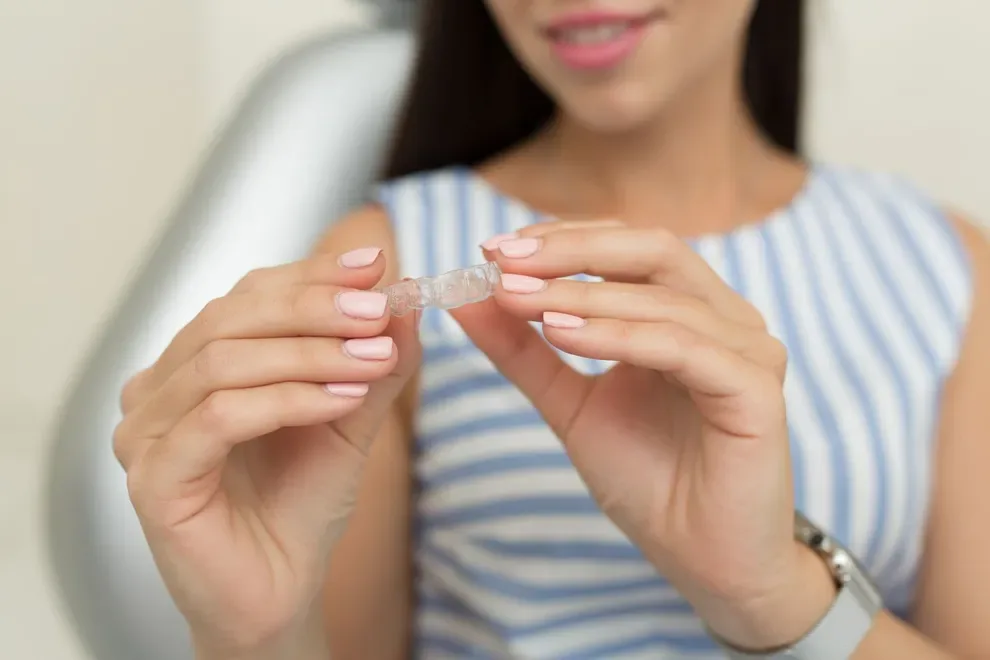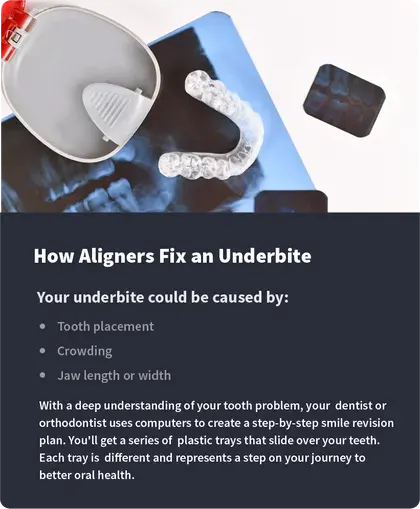Should I Get Invisalign for My Underbite?

Table of Contents
- Invisalign & Other Aligners
- All About Underbites
- Aligners Fix Underbites
- Candidates for Aligners
- Potential Drawbacks
- Alternative Therapies
- Invisalign for an Underbite FAQs
- References
Invisalign can work to correct certain underbites, but it depends on the severity of the issue.
Invisalign & Other Aligner Choices for Underbites
While traditional braces used to be the preferred treatment for an underbite, today’s dental technology offers modern choices when it comes to orthodontic treatment.
Your dentist may have talked to you about Invisalign braces as a treatment option. Invisalign-brand aligner treatment offers some advantages over braces.
For example, Invisalign aligners are clear and may work more quickly than traditional braces. But there may be more convenient and affordable options on the market today.
Clear at-home removable aligners may be able to treat an underbite for a more affordable price than braces or Invisalign-brand products. Because they’re removable and some aligner providers offer a start-to-finish virtual experience with no in-office visits needed, clear aligners can offer the ultimate in teeth-straightening convenience.
All About Underbites
Your upper palate should be slightly longer and wider than your lower palate. When you close your mouth, your upper teeth should go over and cover your bottom teeth. When that doesn't happen and your lower teeth push forward instead, this is an underbite.
Dentists use the term malocclusion to describe a less-than-ideal jaw placement, like an underbite. These issues are relatively common. For example, in some studies, about 31 percent of people have a malocclusion.
Just because they're somewhat common doesn't mean an underbite isn't harmful. Leave the issue alone, and you could deal with the following problems:
Chipped teeth: Your lower teeth could hit your upper teeth too often, and damage results.
Pain: If your muscles are stretched too far and work too hard, it can cause discomfort.
Difficulty: You might find it hard to eat without spitting or talk without lisping.
Keeping your teeth clean is tough when you have an underbite too. Researchers say that the impact on oral health by an untreated underbite is significant. You could deal with cavities, gum disease, tooth loss, and more.
How Aligners Fix an Underbite
Impressions of your teeth, or an in-office tooth scan or impression, starts the process of correcting an underbite. The orthodontic specialist guiding your aligner treatment will be able to examine the impression or image of your teeth and understand why your lower jaw juts forward to create an underbite.

Your underbite could be caused by the following:
Tooth placement. Your teeth could lean forward or backward, forcing your jaw to do the same.
Crowding. If you have too many teeth too close together, your jaw could push forward in response.
Jaw length or width. If your lower jaw is too long or your upper arch is too narrow, an underbite could result.
With an understanding of your tooth problem, your dentist or aligner provider uses software to create a step-by-step smile revision plan. You'll get a series of plastic trays that slide over your teeth. Each tray is different and represents a step on your journey to better oral health and an improved smile.
If you’re using an in-office Invisalign provider, regular in-office visits will be part of your treatment. You may receive all of your aligners at the start of treatment, or they’ll be given to you throughout the process.
If you’re using at-home clear aligners, you’ll check in virtually with the orthodontist who is overseeing your treatment to ensure that your smile is perfectly on track. For example, Byte offers a user-friendly app and access to clinical support every day of the week.
Are You a Good Candidate?
Clear aligners can be used to treat some cases of underbite. Whether you are a candidate depends on the severity of your underbite.
For example, if your lower jaw is too long, teeth aligners may be unable to help. Aligner devices can move teeth, but they can't remove bone or change jaw shape. Only surgery can do that.
Similarly, if your teeth are significantly rotated, aligners may not be ideal. Trays can push teeth forward and back, but adjusting rotation could require a more involved treatment plan.
Before starting your treatment, top aligner providers will ensure that you’re a candidate for aligners. Byte offers a full refund on our at-home impression kit if it’s determined that clear aligners won’t work for your needs.
At Byte, we provide access to doctor-supervised treatment and everyone gets our patented vibration tool for free.
Potential Drawbacks of Invisalign for Underbite Correction
Invisalign was one of the first popular alternatives to braces, which has made them a well-known name in orthodontic options. However, Invisalign products aren’t the only braces alternatives anymore, and they’re not ideal for everyone, especially those who are concerned about the following:
Most Invisalign-brand treatments require in-office visits with an Invisalign provider. These dentist visits can become a hassle, especially if the office is not in your direct area.
Depending on the complexity of your orthodontic issues, Invisalign-brand treatment can cost upward of $3,000. This makes Invisalign one of the most expensive clear aligner options on the market.
For unique or serious cases of underbite, your dentist may recommend an alternative treatment like braces.
Invisalign-brand treatment is handled by a licensed Invisalign provider. That means most treatment issues will be handled with the provider — a dentist or orthodontist.
Issues like billing, service guarantees, and customer service will likely need to be coordinated by the dentist or their office staff. Dental billing and customer service may vary greatly depending on the office and their attitude toward their patients.
Top at-home aligner providers like Byte offer a more modern and straightforward take on these issues by selling their premium aligners directly to consumers for a clearly explained, all-inclusive price. While treatment is monitored and overseen by orthodontic specialists, customer care specialists handle any issues promptly and are readily available through the easy-to-use app.
The Byte for Life guarantee also ensures that anyone who’s completed treatment as directed is able to receive free evaluations and additional aligners as needed.
Alternative Therapies to Fix an Underbite
Invisalign-brand products can help some cases of underbite, but you have plenty of other options, including these:
Traditional metal braces
Ceramic braces (sometimes called invisible braces)
Lingual braces
At-home clear aligners
Cosmetic dentistry
Depending on the severity of your underbite, and your treatment preferences, one of these alternate therapies may be ideal for your situation:
Braces have been used for years to help people with underbites. For some people with a severe or complicated underbite, braces may be the only option besides surgery.
With braces, your orthodontist glues brackets to your teeth, and wires connect them. As the wire shortens and adjusts, your teeth move into their proper positions. If your dentist adds on headgear or elastics, your jaw problems could be properly addressed.
While braces are effective, they also have many negatives.
Costly: Prepare to pay thousands for braces. Some insurance plans won't cover the full fee.
Uncomfortable: Metal bits can poke at your lips and gums.
Hard to clean: You won't be able to brush or floss in the same way with braces, so bacteria might build up.
Easy to see: People often feel self-conscious while wearing braces. Less noticeable alternatives to traditional metal braces, like lingual braces (which attach to the back of the teeth) or ceramic braces (which can be clear or tooth-colored) are available, but they are more expensive.
With clear aligner treatment, a doctor will supervise your care, and you'll move through a series of trays until your teeth take their proper positions. But you'll skip the office visits and higher costs associated with Invisalign.
In studies, at-home aligners are associated with high satisfaction rates. When the treatment is complete, people are happy with their smiles.
At-home aligners can move your teeth quicker than you might think, especially if they're paired with a vibration device, like Byte’s HyperByte device (included free with every aligner set). The movement helps to seat the teeth within the trays, and the gentle motion helps to soothe pain too.
Studies show that these devices can help to shorten treatment times for people with underbites.
For very mild cases of underbite, cosmetic procedures — such as the application of veneers — may be used to make the appearance of the problem less noticeable. However, veneers can be expensive (especially since treatment will likely require multiple tooth coverings), and the underlying orthodontic issue will not be addressed.
Teeth may continue to shift, and the underbite may get worse, eventually requiring orthodontic treatment.
Invisalign for an Underbite Frequently Asked Questions
Invisalign and other clear aligners can correct many cases of underbite, but if the underbite is severe, a more comprehensive treatment plan with traditional metal braces and possibly the use of additional appliances, like an upper jaw expander, may be needed.
If the overbite is caused by skeletal issues in the jaw, surgery may be required.
For those with a mild or moderate underbite, Invisalign may be a more appealing option than braces because the treatment is less noticeable. However, Invisalign can’t correct the most severe cases of underbite. A treatment plan with traditional braces can usually address most cases of underbite (except those requiring surgery).
Invisalign can also be more expensive than traditional metal braces. If you’re considering Invisalign for your mild-to-moderate overbite, but unsure about the costs, you may want to consider clear at-home aligners. Mail-order aligners like Byte offer clear, removable aligners and dentist-supervised treatment as well as more affordable, straightforward pricing and payment plans.
Invisalign may be able to address a class 3 underbite when used in conjunction with other treatments. It depends on your unique orthodontic situation. Ultimately, you will have to go in for a consultation with an Invisalign-licensed dental professional to see if these clear aligners are an option for you.
